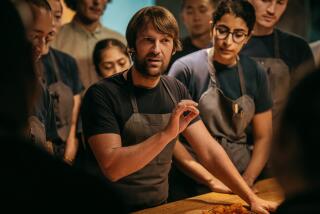Sous-Vide Foods for ‘90s : Vacuum-Sealed System From France
NEW YORK — Now’s the time to pull out the crystal ball and make some predictions for 1989 food and taste trends.
Buzz words for 1989: Oat bran, calcium, boron, beta carotene, lemon grass, fiber, reduced-sugar fruit spreads, hearty breakfasts, cheesecakes, yellow peppers, cranberries, real Cantonese cuisine, uncontrived food, designer menus, premium toasts.
Food & Wine magazine says one of the important innovations of 1989 and the 1990s will be the sous-vide (sealed without air) process of warming precooked, never-frozen meals in plastic bags.
Unlike boil-in-a-bag products that are frozen, dried or chemically treated, sous-vide foods are cooked and placed in vacuum-sealed plastic bags that prevent deterioration for up to three weeks. They need only to be refrigerated and heated through for serving. Popular in France for the last 15 years, sous-vide foods will be available in gourmet stores in the United States for $2 to $6 a package, the magazine says.
New in appliances: steam ovens, such as those by Tefal, that cook rapidly and retain moisture, and extra-wide ovens (twice the width of the average model), such as those by Gaggenau, which are perfect for pizzas.
A Bananorama
“The year of the banana,” will be 1989, according to Food & Wine magazine, with many new varieties making their appearance including manzanos, called apple bananas, from Central America; burros, chunky bananas with a square shape; red bananas, with a purplish skin and reddish tinge inside; and starchy plantains.
Beer drinkers will enjoy dry beer, introduced two years ago in Japan and now available in the United States. The brew is fermented longer, so more sugar is converted into alcohol, making for a drier tasting beer.
And for those who love coffee, the latest innovation is the “espresso pod,” a kind of tea bag for coffee that is precisely measured, pressed and packaged to brew a perfectly intense cup of Italian coffee.
Among Food & Wine magazine’s other predictions:
Mediterranean Cuisine: Mediterranean cuisine fits perfectly with today’s low-cholesterol, high complex-carbohydrate diets. The emphasis is on olive oil, garlic, vegetables, legumes and seafood instead of butter, cream and red meat.
Provencal: Look for classic dishes like bouillabaisse and olive-onion-anchovy pizza, which make use of black olives, garlic, tomatoes, capers, saffron, fish and fresh herbs.
Prosciutto Is Back
Prosciutto: Look for genuine prosciutto from Italy. The federal government has lifted its ban on imported pork products, and lovers of the delicious cured ham from Parma will be able to enjoy the real thing.
Midwestern Cuisine: More folksy than New York, less radical than California, this down-home food is always served in generous portions and is exemplified by dishes such as corn chowder with country ham and Indian persimmon pudding with dried blueberries.
Anything Smoked: Anything smoked promises to be “hot” in 1989, including salmon, scallops, oysters, turkey, quail and venison.
Vegetables: We’ll also see more jicamas in supermarkets, Asian pears year-round, less expensive shiitake mushrooms grown in the United States, sun-dried tomatoes, fresh cilantro, sugar snap peas and Champagne grapes (actually a form of currant).
Executive chef Jon Jividen of Ridgewells Caterer of King of Prussia, Pa., includes “honest” food, “designer” menus and premium toasts among his taste-trend picks for 1989.
Jividen says “honest” food, also called comfort food, down-home cooking, or real food, is the result of the growing availability and appreciation of high quality produce, and the continuing movement away from overwhelmingly complicated ingredients.
Honest foods include fresh veal chops, pan-fried and lightly seasoned; home grown vegetables, steamed and served with a little lemon or butter; home grown herbs; and made-from-scratch biscuits.
Celebration of Ingredients
“This is not steak mania,” Jividen says, “it is rather a celebration of great ingredients prepared perfectly. There is elegance here, with simplicity.”
Those who crave variety will find it in controlled designer menus with complimentary flavors unjumbled and separated into different courses or side dishes.
For example, instead of putting fennel into the veal Marsala, Jividen says, veal Marsala will be served as it was classically conceived, and the fennel will give flavor to the accompanying bread.
Other possibilities: a mesquite-grilled tenderloin will be left as is, with roasted peppers and corn bread on the side; pork roast may have caraway cabbage on the side; bouillabaisse will be complimented with a saffron pasta; fresh trout will have cashew breading and will be served with a wild mushroom timbale.
More to Read
Eat your way across L.A.
Get our weekly Tasting Notes newsletter for reviews, news and more.
You may occasionally receive promotional content from the Los Angeles Times.










